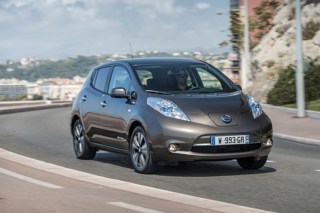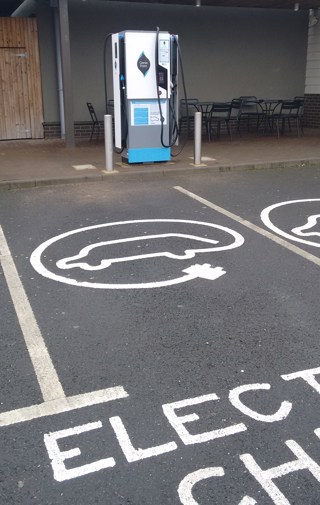Edinburgh College has saved more than £100,000 in fuel expense claims since introducing an electric pool car fleet as an alternative to the grey fleet in 2012.
The cars are used to travel between the college’s four campuses, with an average daily trip distance of 5.32 miles.
To date, college staff have clocked up 230,000 miles in the electric vehicles (EVs), saving the college £103,500 (based on it reimbursing staff who use their own cars for business trips at the Approved Mileage Allowance Payment rate of 45 pence per mile).
The cost of charging is minimal as the college has solar panels at Granton campus and a solar meadow at its Midlothian campus, although energy from the latter goes direct to the grid rather than to run the buildings.
The launch of the pool car scheme co-incided with formation of Edinburgh College in October 2012 from the merger of three Edinburgh-based colleges: Jewel and Esk, Telford and Stevenson.
Two of the colleges already had experience of EVs.
Jewel and Esk had conducted a research programme in 2011 which looked at how EVs were perceived and how they could be used, with Stevenson using an EV as part of the research project.
“When we merged colleges we needed staff transport between the campuses and we were looking to reduce grey fleet mileage costs, and the electric cars were perfect to address that,” explains electric vehicle administrator Bob Murphy (pictured).
Murphy is a former student at the college and completed a City & Guilds Level 2 Automotive course before being employed to manage its pool car fleet.
Initially, Edinburgh College had four electric Mitsubishi i-Mievs but the fleet has since expanded to 11 EVs (three Nissan Leafs, three Mitsubishi i-Mievs, four Nissan e-NV200 vans and an Allied Electric eMonarch minibus), with four BMW i3s on order.
Using electric vehicles has saved the college 50 tonnes of CO2 since 2012.

The college’s facilities team still operates four large diesel vans to transport bulky items and three diesel minibuses.
Murphy would like the fleet to eventually be fully electric but it is dependent on what the manufacturers bring to market.
“With things like the Renault Master ZE coming out you’ve got a bigger van that is going to be more practical for more companies,” Murphy says.
“The Nissan vans are great but they are a wee bit too small for some of the things that our guys need them for, particularly for large engineering bits and pieces, and for carrying furniture around and stuff like that. A slightly bigger van is a preferred option.”
Range is also a factor as some of the college’s maintenance staff do “intergalactic mileages” every day, according to Murphy, and the range available now is not sufficient.
“You’ve got to factor in the downtime while you wait for them to be charged and that might only be half an hour. But if that’s half an hour four times a day, that’s two hours out the working day that you’ve to got account for.
So you’ve got to look at that from a pragmatic point of view,” he says.
“As time goes on that will get better, the battery technology will improve, the efficiencies will improve. It’s a ‘watch this space’ situation.”
All of the college’s vehicles have been leased from Automotive Leasing, the public sector arm of LeasePlan, with the majority on three year contracts and 10,000 miles per annum.
The bulk of the funding for vehicles has come through the statutory Regional Transport Partnership SEStran (South East Scotland Transport Partnership).
The college has also had support from Transport Scotland’s Switched on Fleets scheme, which provides funding to public sector fleets to increase the number of electric vehicles on the road.
However, Murphy believes the business case stacks up even without funding support.
“We’ve got more than enough data now to back up the business case,” he says “We’ve saved more than £100,000 in grey fleet fuel costs alone, just by using the electric cars instead of staff-owned cars for transport. The running costs are minimal, the cost for electricity is so much less than it would be for petrol or diesel.
“So, even without the funding there, we’ve got more than enough information that would build the business case for any small businesses interested in doing it.”
All the vehicles are fitted with trackers from UK Telematics (formerly Track You), which has enabled Murphy to supply the college’s executive team with a monthly report showing increased usage over time.
Data gathered from the EVs is also passed on to students on engineering, automotive and electrical courses as the use of electric vehicles is embedded in the curriculum.
“They’ve got that real-life information they can use to determine things like emissions saved,” Murphy says.
“But it works across campus for all the students. We had film and photography students involved in doing a training video for us a few years ago so staff would get an idea how to use the cars because they’re a wee bit unconventional for some people.”
The video is available to staff through the pool car booking system.
“We’ve also been able to take the cars out to STEM (science, technology, engineering and mathematics) events and things like that and take them to high schools and talk about them and demonstrate them to pupils. From an educational standpoint they’ve been very useful.”
Murphy believes it is important for the younger generation to be educated about electric vehicles because “it’s often difficult to change someone’s opinion when they’re set in their ways”.
“That was one of the obstacles we came across trying to get staff into the cars,” he says.
“A lot of them were saying, ‘I’m not going to drive that because the battery is going to run flat’. The younger folk are more open to it. It’s important to give them that experience, to talk about it, just to get them thinking differently and open their minds a bit more to the possibilities that are available nowadays,” Murphy adds.
He has overcome employees’ initial perceptions of EVs simply by getting them behind the wheel at staff open days.
“We’ve always found as soon as someone sits in the car and gets the chance to drive it their perceptions change quite a fair bit and all of a sudden it goes from being a novelty to something serious,” he says.
“Even though the electric car renaissance, if you like, has been going since 2009/2010, some people still think of them as milk floats – it’s slow and it’s heavy and it’s not as much fun to drive.
“Get them behind the wheel and you can almost tell the moment the perception shifts.”
The college now has 591 registered users on the pool car booking system (up from 20 when the scheme launched) and staff are even buying their own pure electric vehicles.
“That’s another good indication of how influential it’s been,” Murphy says.
Staff receive a half-hour induction before they drive an electric car, covering how to get the best out of the vehicle, and how and where to charge them.
The college has 28 charging sockets, 23 of which are available to the general public and car clubs.
Initially, students at Jewel and Esk designed and built the charging points and then the college was able to get funding from the Government through Energy Saving Trust (Scotland).
Whether any more charging points will be installed depends on the buildings.
“We’re finding now that the buildings need to be upgraded in order to put more charge points in the car park,” Murphy says.
“That’s something a lot of people will be wrestling with because of the way things have been built. Nobody thought 30 or 40 years ago when the buildings were erected that they’d ever have to put electricity through the car park for charging points.”
The college also makes use of ChargePlace Scotland, a national network of EV charge points.
If a member of staff wants to take an EV for a long distance business trip Murphy will assist with route planning, taking into account how many stops will be needed to charge the vehicle.
“We put that support in place for people that are doing longer journeys so they know where they can go and they’ve got a bit of confidence they will be able to get there,” Murphy says.
No one has run out of charge, apart from Murphy – and that was done deliberately.
“Part of the research was to find the limits and push the limits so if someone came up to us and said, ‘can I drive to Dunbar?’ We could say with a degree of confidence, ‘yes, you can, provided you don’t drive like Michael Schumacher’.”
The maximum range Murphy has reached in a 24kW Leaf is just over 100 miles.
“For a 24 kilowatt Leaf we can confidently say, ‘expect 80 to 90 miles before you’re going to have to plug it in and charge it’. They can maybe stretch that out if they drive a bit more cautiously,” Murphy says.
“You’re never going to get the 124 miles they claim for NEDC (New European Driving Cycle) because that’s done in a lab and it’s not real-life conditions.”
For one of the college’s Nissan e-NV200s, Murphy expects a range of 80 to 90 miles when the van is empty and for that to “come down a fair bit” when fully loaded, dependent also on driving style and weather conditions.
There have been no vehicle reliability issues.
“We take pains to try and make sure the cars are kept in good condition so they get regular checks done on them – the fluids, tyre treads and cleanliness, basic maintenance,” Murphy says.
The BMW i3s are expected to the join the fleet before the new teaching semester starts at the end of August.
They will enable Murphy to look at grey fleet drivers and the journeys they are making to see whether they could use an electric vehicle instead.
Murphy’s advice for other businesses considering adding EVs to their fleet is to first carry out a travel survey to identify where the vehicles could be deployed.
“Get an idea of what your existing costs are so you can make a comparison against electric vehicle costs and the savings to be made there because you’ve got things like your total cost of ownership and your payback times to consider,” he says.
“If you know where you are starting from it makes it a lot easier to build a business case and get the cars on the road.”




















Login to comment
Comments
No comments have been made yet.